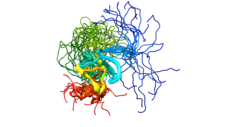PRDM16 in WAT
White adipose tissue (WAT) primarily stores excess energy in the form of triglycerides. [7] [9] Recent research has shown that PRDM16 is present in subcutaneous white adipose tissue. [7] The activity of PRDM16 in white adipose tissue leads to the production of brown fat-like adipocytes within white adipose tissue, called beige cells (also called brite cells). These beige cells have a brown adipose tissue-like phenotype and actions, including thermogenic processes seen in BAT. [7] In mice, the levels of PRDM16 within WAT, specifically anterior subcutaneous WAT and inguinal subcutaneous WAT, is about 50% that of interscapular BAT, both in protein expression and in mRNA quantity. [7] This expression takes place primarily within mature adipocytes. Transgenic aP2-PRDM16 mice were used in a study to observe the effects of PRDM16 expression in WAT. [7] The study found that the presence of PRDM16 in subcutaneous WAT leads to a significant up-regulation of brown-fat selective genes UCP-1, CIDEA, and PPARGC1A. This up-regulation lead to the development of a BAT-like phenotype within the white adipose tissue. Expression of PRDM16 has also been shown to protect against high-fat diet induced weight gain. [7] Seale et al.’s experiment with aP2-PRDM16 transgenic mice and wild type mice showed that transgenic mice eating a 60% high-fat diet had significantly less weight gain than wild type mice on the same diet. Seale et al. determined the weight difference was not due to differences in food intake, as both transgenic and wild type mice were consuming the same amount of food on a daily basis. Rather, the weight difference stemmed from higher energy expenditure in the transgenic mice. Another of Seale et al.’s experiments showed the transgenic mice consumed a greater volume of oxygen over a 72-hour period than the wild type mice, showing a greater amount of energy expenditure in the transgenic mice. [7] This energy expenditure in turn is attributed to PRDM16’s ability to up-regulate UCP-1 and CIDEA gene expression, resulting in thermogenesis.
If human WAT expresses PRDM16 as in mice, this WAT could be a potential target for stimulating energy expenditure and combating obesity.
This page is based on this
Wikipedia article Text is available under the
CC BY-SA 4.0 license; additional terms may apply.
Images, videos and audio are available under their respective licenses.




